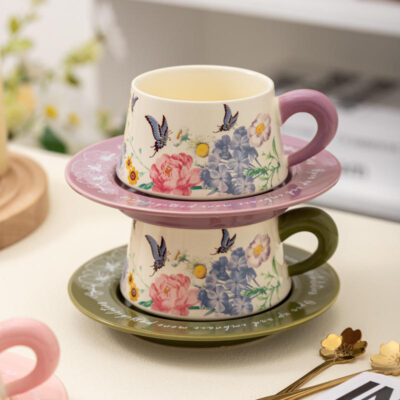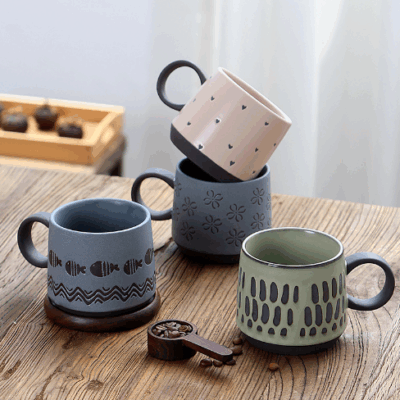Behind every ceramic mug lies a story of craftsmanship, precision, and transformation. Whether you’re a café owner, gift retailer, or product designer, understanding the production process helps you evaluate quality and choose the right ceramic mug manufacturer for your brand.
🏺 1. Selecting and Preparing the Clay
The journey begins with raw materials. A professional ceramic mug factory carefully selects clay blends of kaolin, feldspar, and quartz. These minerals determine the mug’s color, weight, and durability. The clay is filtered, kneaded, and de-aired to remove bubbles, ensuring smooth texture and uniform density — the foundation for every perfect mug.
⚙️ 2. Shaping and Forming
Once the clay is prepared, it’s time to give it form. Depending on the design and order size, factories use pressing, slip casting, or wheel molding.
-
Pressing offers consistency for mass production.
-
Slip casting enables delicate shapes and artistic details.
-
Wheel molding is used for limited handmade collections.
At this stage, the mugs are still fragile “greenware” and must dry evenly to prevent cracks.
🔥 3. Bisque Firing – The First Transformation
Dried mugs undergo their first firing, known as bisque firing, at around 850°C. This step removes all moisture and hardens the clay without melting it. The mug becomes strong enough for glazing and decoration. Skilled kiln control is crucial — inconsistent temperature can distort shape or color. A reliable ceramic mug manufacturer ensures stability and accuracy during this phase.
🎨 4. Glazing and Coloring
Glazing gives the mug its unique finish and protection. Glazes can be transparent, glossy, matte, or speckled, depending on brand aesthetics. The mugs are dipped or sprayed with glaze and dried carefully before the second firing.
For custom ceramic mugs, brands can choose dual-tone glazes, reactive finishes, or gradient effects to stand out in retail or promotional markets. These small visual differences define a brand’s personality and style.
🔥 5. Glaze Firing – Strength and Shine
The second firing is the most critical stage. At 1,250–1,350°C, the glaze melts and bonds permanently with the clay body, creating a smooth, non-porous surface. This firing gives the mug its final color, hardness, and durability.
Modern ceramic mug factories use automated kilns with precise temperature controls to ensure every piece is consistent. A good glaze firing produces a mug that is dishwasher safe, microwave safe, and visually flawless.
🖋️ 6. Decoration and Logo Printing
After cooling, mugs move to the decoration area. This is where branding comes to life. Techniques include:
-
Decal printing: For colorful, detailed artwork.
-
Sublimation: For full-color photo-quality images.
-
Laser engraving: For elegant minimalist designs.
Each method has its own visual impact and durability. Once decorated, mugs are fired again at lower temperatures (700–800°C) to seal the design permanently. This ensures your logo won’t fade even after hundreds of washes.
🧪 7. Quality Control and Inspection
Every ceramic mug factory follows strict inspection standards before packaging. Workers check each piece for glaze uniformity, shape accuracy, and printing precision. Defective mugs are removed, while approved ones go through durability tests — impact resistance, dishwasher cycles, and lead safety checks.
Quality control not only guarantees safety but also builds long-term trust with international buyers.
📦 8. Packaging and Export Preparation
Finally, each mug is carefully packed using foam dividers or custom boxes. Bulk buyers can request private-label packaging, barcode labels, and retail-ready designs. Factories offering OEM and ODM services also provide support for drop tests and carton compliance, ensuring smooth international shipping.
Strong packaging reduces breakage and strengthens the brand presentation once the mugs reach customers.
🌿 9. Sustainable and Safe Manufacturing
Today’s ceramic mug manufacturers are embracing eco-friendly production. Many adopt lead-free glazes, water recycling systems, and energy-efficient kilns to minimize their environmental footprint. Sustainable practices also make products more appealing to eco-conscious brands and consumers.
☕ Conclusion
The process of making ceramic mugs is a delicate balance of science, art, and experience. From selecting the clay to perfecting the glaze, every stage defines the mug’s final beauty and performance.
Working with a professional ceramic mug manufacturer means gaining access to years of expertise, modern equipment, and strict quality assurance. Whether you need custom ceramic mugs for branding or wholesale distribution, understanding the production process helps you make smarter decisions — and ensures your mugs carry not only your logo but also your values.








